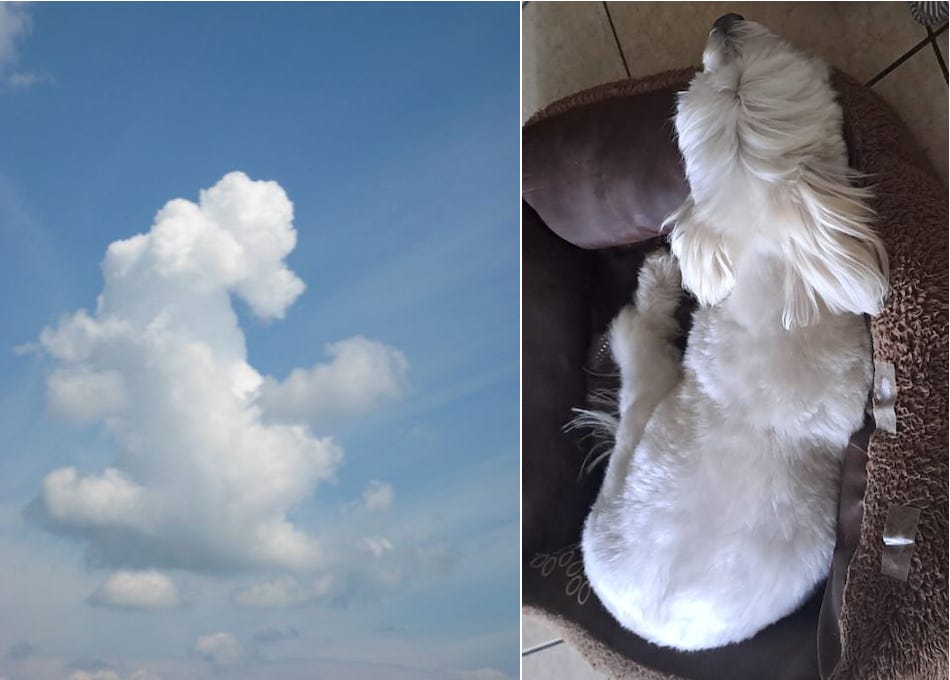Metaphors
Pervasive in our everyday lives, they influence not just language, but also our thoughts and actions.
I worked in and around insurance and financial services for more than fifteen years. During those years, I gained a more nuanced understanding of the distinction between risk and uncertainty.

Uncertainty and risk are concepts in economics and the stock market. The concepts are related, but not the same. You cannot avoid risk, every act of creation involves it. Even not doing anything has a risk component.
We can learn to move away from uncertainty for important decisions. Focus on what matters, test a lot of stuff, do more research, along with alternative plans are all useful methods to think about and operate within a volatile situation.
The ability to think through difficulties has value. And we can improve it when we design and use metaphors that are more appropriate for us.
Reminder: You can support my work and get extra insights—in-depth information, ideas, and interviews on the value of culture.
Join the premium list to access new series, topic break-downs, and The Vault.
Metaphors structure the way we talk, but they also impact the way we think. A metaphor is a figure of speech in which a term or phrase is applied to something to which it is not literally applicable in order to suggest a resemblance.
They’re a fundamental mechanism of mind, one that allows us to use what we know about our physical and social experience to provide understanding of countless other subjects.

If we compared two different and conflicting metaphors of our age—facts and risk—we might realize that credulity is the new skepticism. But first a thesis put forth by Taleb: rationality-as-risk-management.
“Beliefs are investments that require due diligence.”
The most useful concept from the comparison of metaphor of facts (Wittgenstein’s Revenge) with metaphor of risk management is that the latter implies beliefs are investments, requiring due diligence as a practical necessity.
This is a brilliant concept because it frees us from the belief that today’s prevailing opinions (or those in our bubble) is a moral imperative. Instead, it invites us to weigh the risks of being mistaken against the rewards of being correct.
Risk management, metaphorically speaking, is also pro-science. True scientific thinking is about updating knowledge as new information we can prove comes along. Thus we can come to realize that, as Isaac Asimov wrote, right and wrong are not absolutes.
The value of this idea is that it uncovers the veil of ‘certainty’ illusion and reduces the psychological vulnerabilities created by the expectation of certainty—e.g., propaganda, tribalism, and social division. (When it comes to skills and craft, I prefer the word ‘guild’ to ‘tribe’—it’s much more accurate based on the historical period I wish to reference.)
Good-faith discourse is another positive outcome of using risk management as our metaphor. Many predictions fail based on our confusion between risk and uncertainty. For example, the poor decisions (or lack of due diligence) that led to the 2008 financial crisis.
“Risk, as first articulated by the economist Frank H. Knight in 1921, is something that you can put a price on. Say that you’ll win a poker hand unless your opponent draws to an inside straight: the changes of that happening are exactly 1 in 11. This is risk. It is not pleasant when you take a ‘bad beat’ in poker, but at least you know the odds of it and can account for it ahead of time. In the long run, you’ll make a profit from your opponents making desperate draws with insufficient odds.
Uncertainty, on the other hand, is risk that is hard to measure. You might have some vague awareness of the demons lurking out there. You might even be acutely concerned about them. But you have no real idea how many of them there are or when they might strike. Your back-of-the-envelope estimate might be off by a factor of 100 or by a factor of 1,000; there is no good way to know. This is uncertainty.
Risk greases the wheels of a free-market economy; uncertainty grinds them to a halt.”
Nate Silver
The architects of the crisis spun uncertainty into what looked and felt like risk. We lived the consequences of those decisions. ‘Credulity is the new skepticism’ is an interesting twist.
Are we asking, “what if I’m wrong?” enough? We should worry we fail to ask, “what if the prevailing worldview is wrong?” Because that’s when we stay stuck as a society or nation.
Could metaphors help us shift reference points and prime our (unused) imagination? Could we push beyond memes and slogans to design new ways of looking at things that are not so restrictive and binary (code)?
“If you could ask Dante where he got the idea of life as a road, or Rilke where he found the notion that time is a destroyer, they might have said the metaphors were hewn from their minds, or drawn from a stock of poetic imagery. Their readers might have said the imagery had origins more divine, perhaps even diabolical. But neither poets nor readers would have said the metaphors were designed. That is, the metaphors didn’t target people’s cognitive processes. They weren’t engineered to affect us in a specific way.
[...] metaphors are meant to help people to understand the unfamiliar. They aren’t supposed to make someone remark: ‘That’s beautiful.’ They’re meant to make someone realize that they’ve only been looking at one side of a thing.”
Michael Erard, Aeon
To do that, we need to acknowledge that our language and our culture’s resources are finite. They’re not as versatile as we thought. The richness of the semantic resources at our disposal meets friction—the human brain’s has built-in biases and preferences.
Cultural defaults block certain kinds of understanding. Our current metaphors have run out of juice. They over-simplify certain aspects of the world and obscure reality. For example, “is running a national economy really like balancing a household budget?”
Perhaps we should look at metaphors as mere categorization proposals to take with a grain of salt. Princeton psycho-linguist Sam Glucksberg think of metaphors as provocations.
“You’re suggesting that one thing belongs with another. But the thing that lets us make sense of ‘paintbrush as pump’—or ‘lawyer as shark’—is that ‘pump’ is the name of a category for liquid-moving mechanisms, just as ‘shark’ is the name of the category for predatory individuals. Words such as ‘pump’ and ‘shark’ aren’t just the names of individual things; they also speak to generalities. They have ‘dual reference’.
Others have become conventionalized metaphors. ‘Butcher’ refers to ‘anyone who should be skilled but is incompetent’, ‘jail’ to ‘any unpleasant, confining situation’, ‘Enron’ to ‘any dramatic accounting scandal’, and ‘Vietnam’ to any ‘disastrous military intervention’.”
Choreographer Twyla Tharp says comparing is the engine that drives metaphor. She suggest some exercises to sharpen our mental acuity.
1. Visual translation—note how many images and objects you see in three minutes of cloud-gazing. I love doing this one when at the beach. In fact, a few years ago, I found our little angel Tommy in the sky.

2. Metaphor as object or task—try to find a rhythm of the process while doing a mindless chore like washing the dishes. Hum it, name it, then find other chores/tasks with a similar rhythm. I have a mantra that is perfect from my fast walks and gives me a sense of peace.
3. Metaphor as aural and visual stimulus—distill a mechanical sound and mimic it. This reminds me of the VW windshield wipers commercial.
4. Metaphor as faith—what images come to mind when focusing on superstition like knocking on wood to bring luck? There’s a cultural component here. In Italy we touch metal for luck.
5. Metaphor as theater—by studying a word’s linguistic roots trace how far it takes you. For example, the word tragedy... makes me think of goats. You will figure out why if you do the exercise. The word also reminds me of the unpredictability of fate.
6. Metaphor as curation—find works of art you can connect together. They are more mundane items, I’ve been doing this by cataloging my Sunday links under themes (for example how to conquer information overload.)
7. Metaphor as empathy—by turning Narcissus around and trying to see another person in your image. All those comparing images for differences in objects exercises in the crossword puzzles do pay off.
Humans are not as resilient and robust as other forms of life. But we are thinking beings. That has value. It’s something wise people have discovered centuries ago. In Pensées, Blaise Pascal1 says:
“Man is but a reed, the weakest thing in nature; but he is a thinking reed. The entire universe need not arm itself to crush him. A vapor, a drop of water suffices to kill him. But, if the universe were to crush him, man would still be more noble than that which killed him, because he knows that he dies and the advantage which the universe has over him; the universe knows nothing of this. A thinking reed.—It is not from space that I must seek my dignity, but from the government of my thought. I shall have no more if I possess worlds. By space the universe encompasses and swallows me up like an atom; by thought I comprehend the world.”
Things are changing faster than the pace of human response. The shock of the changes uncertainty brings is not just physical. We can learn with others to further our ability to make sense of what we’re thinking by talking it out with them.
We’ve been there before. History is full of examples of things we’ve tried and failed at because we didn’t understand uncertainty and our odds. Perspective is valuable—that’s why we say perspective is something we gain.
References:
Lakoff, George and Johnson, Mark, Metaphors We Live By (University of Chicago Press, 2003)
Silver, Nate, The Signal and the Noise: Why so Many Predictions Fail - but Some Don’t (Penguin Press, 2012)


